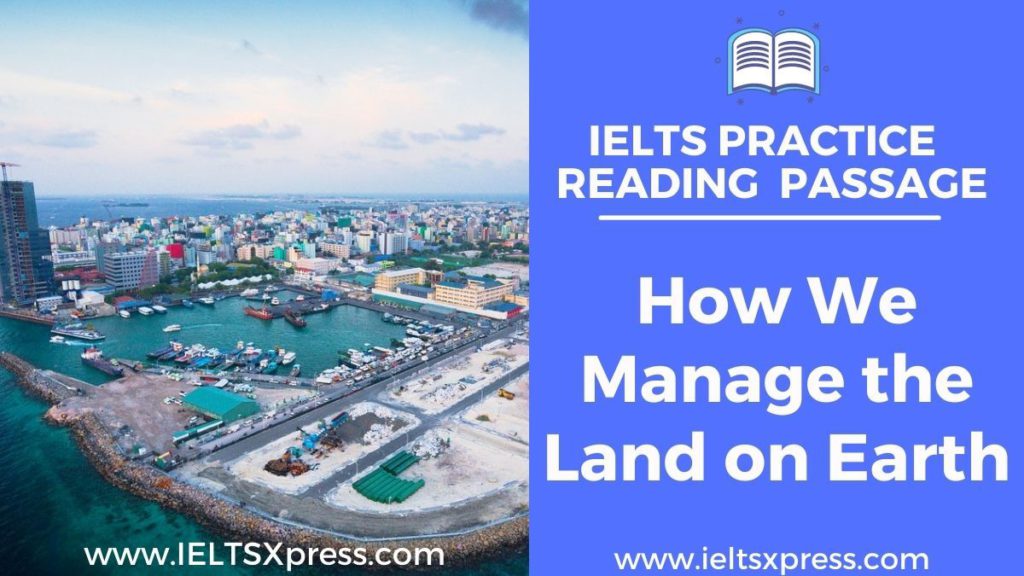How We Manage the Land on Earth IELTS Reading Passage with Answers
Reading Passage 1
You should spend about 20 minutes on Questions 1-12 which are based on Reading Passage 1 below.
How We Manage the Land on Earth
Overpopulation, climate change, mass migration, farming issues and the use of natural resources are all affecting our relationship with terra firma, and it has never been more complicated. It is increasingly looking like Earth’s land is being overlooked rather than valued as precious resource.
For those living in Malé, the overcrowded capital of the Maldives, there is no choice but to build upwards. Caged by the sea, they have no more land to spread onto, yet the city’s population has soared by nearly 52% since 2006. The last census in 2014 counted 158,000 people crammed into the city’s 5.7 sq km of space, and officials say the figure has since grown further.
Space is such a premium in Malé that pavements are often less than one metre wide, forcing pedestrians to walk in single file, while many streets have no sidewalk at all.
Malé, capital of the Maldives, is emblematic of modern-day land issues: A small, increasingly urbanising space with a skyrocketing population. Rents have risen exorbitantly and, in some of the poorest areas, up to 40 people can be squeezed into buildings with just 23.2 sq metres of space – about the same size as a small studio flat.
With so many people living under each other’s feet, crime, drugs and domestic violence have risen alarmingly while the city frequently runs out of water. An entirely new island has risen next door out of the sea itself simply from the city’s garbage.
In the early 1990s the tallest buildings in the city were only two storeys high, whereas now the average height is eight storeys and some are as high as 25 storeys high. People are coming here because this is where the health, education and jobs are, but overpopulation is leading to many socioeconomic problems.
Although extreme, Malé is an example in miniature of something that is happening on a far larger scale around the world. With 83 million more people appearing on the planet every year, rising populations are placing increasing pressure on the land.
The UN’s latest estimates state that there are 7.6 billion people jostling for space on Earth at present and that number will rise to 9.8 billion by 2050. By the end of the century, their projections say there could be 11.2 billion people on our planet.
With 83 million more people appearing on the planet every year, rising populations are placing increasing pressure on the land. Each of those people will need somewhere to live, a place to work and fertile land to provide them with food. They will need water and energy to stay warm or to light their way at night. They will want roads to drive on and places to park. For the lucky ones, there will be space for their pastimes and leisure activities.
At first, it can be easy to dismiss fears that mankind may one day run out of space as ridiculous. Physically, the land can easily accommodate 11 billion people – there are around 51.7million sq miles of ice-free land on the planet.
But large tracts of land remain virtually uninhabitable due to their climate or their remote location: Enormous tracts of Siberia are too inhospitable to be lived upon, and the huge landmass at the centre of Australia is too arid to support many people, meaning the majority of its population is clustered along its coastline.
The cities and towns we live in account for less than 3% of the Earth’s total land area, but between 35% and 40% is used for agriculture. As populations grow, many fear that more h land will be used up to grow more food. And land management has a lot to do with resource management – what eat, how we grow it, and how we eat it.
To feed the world’s growing population, a study by researchers at Stanford University estimated that between 10,400-18,900 sq miles of additional land will be required, and that there is a reserve of 1.7 million sq miles thought to be suitable for growing crops left in the world.
The researchers predicted that increasing demand for food, biofuels, industrial forestry and the spread of urbanisation will result in this reserve of land being completely used up by 2050.
The bad news is that the demand for new cropland and pastures for animals is already thought to have caused 80% of the deforestation taking place around the world today, wiping out large areas of rich biodiversity and trees that act as natural sinks for greenhouse gases.
The way we use land right now is extremely inefficient, so much of our land is being used to grow food for livestock – 75% of the world’s agricultural land is used for feeding animals that we then eat ourselves. About 40% of the food grown in the world is also never eaten by anybody – it is thrown away.
Questions 1-4
Read the text and choose the correct letter, A, B, C or D.
Write the correct letter on your answer sheet for questions 1-4.
1 The height of most city buildings are now measured to be at a general level of
A 25-storeys
B 2-storeys
C 8-storeys
D 40-storeys
2 The estimated spare land available that is considered to be good for agricultural use, such as the growing of vegetables is
A 51.7m sq miles
B 1.7m sq miles
C 10,000 sq miles
D 18,900 sq miles
3 The current population figure produced by the United Nations for our planet is an estimated
A 11.2 billion
B 11 billion
C 7.6 billion
D 9.8 billion
4 The percentage figure for the food we humans grow on Earth that is discarded as waste is approximately
A 75%
B 3%
C 52%
D 40%
Questions 5-8
Do the following statements agree with the information given in the passage on the previous page?
In boxes 5-8 on your answer sheet, write
TRUE if the statement agrees with the information
FALSE if the statement contradicts the information
NOT GIVEN if there is no information on this
5 From 2006 onwards, the rate of city dwellers in the Maldivian capital has grown at just under 50%.
6 Walking single file is common on the pavement due to the crowding.
7 Water shortages are an almost every day occurrence in the city mentioned.
8 Large portions of the land on Earth are completely unsuited for human occupation.
Questions 9-12
Complete the sentences below.
Write ONE OR TWO WORDS ONLY to complete the sentences.
Write your answers in boxes 9-12 on your answer sheet.
Almost 52 million sq km of land is available to handle the more than 11 billion projected populations as it is classified as being 9 __________
Whereas cities account for less than 5% of land usage, just over a third of the land available on Earth is used for 10 __________
The loss of vast expanses of healthy forests that act naturally to absorb 11 __________
A brand new piece of man-made land has been formed besides the current city, jumping out from the sea itself, made solely by using unwanted 12 __________
How We Manage the Land on Earth IELTS Reading Passage Answers
Practice with Expert IELTS Tutors Online
Apply Code "IELTSXPRESS20" To Get 20% off on IELTS Mock Test
1. C
2. B
3. C
4. D
5. FALSE
6. TRUE
7. NOT GIVEN
8. TRUE
9. ice-free
10. agriculture
11. greenhouse gases
12. garbage
Also Check: Are Artists Liars IELTS Reading Passage








1 thought on “How we manage the land on Earth IELTS Reading Passage”
Book